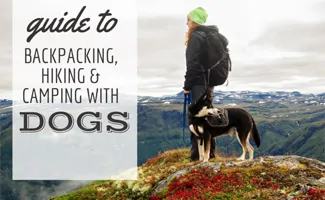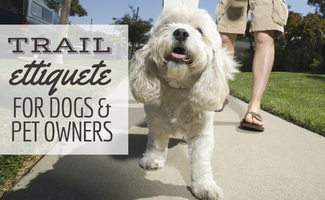
To keep the lights on, we receive affiliate commissions via some of our links. Our review process.
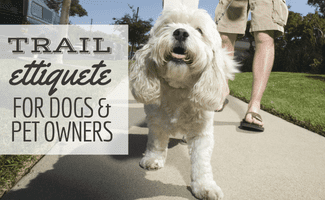
Dog owners can spend close to 300 minutes each week walking their dogs — that’s nearly five hours of outdoor activity. Many pet owners choose to walk their dogs on public trails, introducing their dogs to wildlife, fresh air, and even other dogs.
When dogs — and people — come into contact with each other on public trails, everyone needs to uphold trail etiquette. These standards help protect the animals and owners who regularly use the paths, ensuring that every trail user has a positive outdoor experience.
Obey Leash Rules Of The Area
Contents
Particularly for owners who might enjoy hiking or backpacking with a dog, there can be a temptation to remove a pet’s leash in an open area. However, if there’s a sign indicating that dogs are to be kept on leashes at all times, there’s probably a good reason for it.
Even if you’re a dog-friendly individual, other individuals on the trail may not be. Keeping your dog on a leash provides a comfortable distance between yourself and other trail users. In addition, leashes help prevent unpleasant interactions between unleashed dogs.
Leashes do more than protect passersby from overenthusiastic dogs. They also help to keep your dog safe from any obstacles or dangers they might face on the trails. While many trails are maintained by public parks departments, they’re still located outdoors. As a result, you might come across insects, predatory plant species, and even wild animals during your walk. Leashes help you, and all owners, keep pets from harm.
Even a leashed dog can experience an injury on a public trail. Uneven terrain, prickly bushes, and other hazards can sometimes cause accidents — even for dogs and owners walking on familiar trails. Still, leashes help keep these issues to a minimum and assist pet owners in controlling their dog’s safety.
Stand Aside For Other Walkers And Their Pets
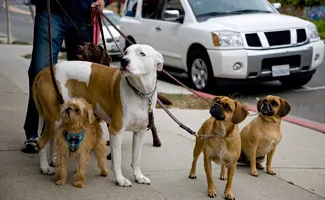
All dogs, and dog walkers, walk at a different pace. Some dogs enjoy a leisurely place during a walk; other dogs prefer to maintain a brisk walk from the beginning of the trail to the end. Sometimes, dog walkers will set a pace they expect their dog to uphold.
When walking your dog on a trail, it’s important to be mindful of your pace and that of others. If you notice a dog walker and their pet approaching from behind, stand aside and allow them the space to pass.
Allowing other trail users the space to pass helps keep others safe from potential leash tangles. In addition, you’re helping ensure smooth interactions between animals. If your dog or other dogs don’t play particularly well with others, allowing others to pass helps prevent any potentially volatile situation.
Pick Up Your Pet’s Droppings

It might seem like common sense to clean up after your pets. Still, many pet owners neglect to pick up droppings after their pets relieve themselves along the trail. This makes for an unsightly experience along the trail and can even present a health hazard to other pets who might ingest the droppings.
Trail maintenance staff often work hard to preserve the integrity of public trails. They will routinely groom trails to remove debris, empty trash cans and add trail signs to clarify walking directions. Some public trails even offer water fountains for both pets and their owners. When pet owners leave droppings behind, they disrespect park staff and create more work for them.
Make Sure Your Pet Has All Shots And Vaccinations
Pets come across a wide range of people, animals, objects, and wildlife while walking a trail. There’s nothing worse than exposing your dog to something contagious, particularly when a shot or vaccine could have prevented the reaction.
Shots and vaccines help to keep your pet safe from a wide variety of dangers they might face. For example, the rabies vaccine helps reduce your pet’s risk of death after direct exposure to a rabid animal. Similarly, the canine distemper vaccine helps protect your pet from a virus that can cause fever, coughing, brain damage, even death.
Regular shots and vaccines provide extra protection for your dog against disease, infection, even insects. Particularly if your dog maintains an active lifestyle, you may also be weighing the benefits of pet insurance. Primarily for emergencies, pet insurance can help you save money if your dog requires surgery, expensive medications, or other urgent procedures.
If you’re considering pet insurance for your dog, take the time to weigh the benefits and drawbacks of different coverage packages. No matter your dog’s individual needs, you’ll be able to find a pet insurance plan that accommodates your pup.
Go Only Where Dogs Are Permitted
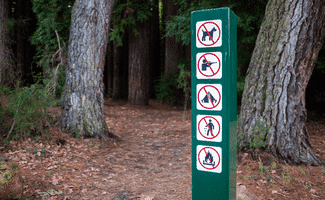
There’s nothing wrong with allowing your dog to express their creativity during a walk on local trails. Providing your dog the time to sniff plants and trail objects helps exercise their brain and keep them engaged. However, it’s important to keep animals in areas where they are permitted. Animals who go out of designated areas always run the risk of injuring themselves in unfamiliar or treacherous territory. It would be a good idea to review your pet insurance to make sure it covers such an incident.
By taking your pet into an area where dogs are not allowed, you’re inconveniencing anyone looking to enjoy a dog-free visit to the park. In addition, you are likely to receive a citation, fine, or ticket from park management or law enforcement after you breach park rules.
Don’t Assume All Other Dogs Are Friendly
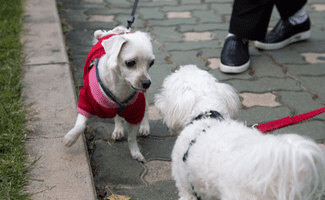
In many cases, you and your dog can enjoy pleasant interactions with other owners and pets. You might even make new friends along the trail. However, make sure to approach others cautiously during the first interaction. No matter their first impression, not all dogs interact well with other animals.
If someone approaches you and their dog wants to play with your pet, you might be tempted to allow your dog to interact immediately. However, experienced pet owners know not to assume that all dogs are friendly. Rather, they will optimistically approach other owners and their pets but will allow dogs to introduce themselves first at a distance.
Once your dogs are comfortable at a distance, and you’ve confirmed with the other owner that they consent to your pets interacting, you can allow your dogs to interact safely. Make sure to keep an eye on their actions, particularly in the first few minutes, so that you can intervene if necessary.
Despite your best intentions, sometimes interactions with another dog can cause injury. If this occurs, it’s always a good idea to have a canine first aid kit handy. Inside, you’ll find items that help you address any bites, scratches, or sprains your dog might have experienced. Some canine first aid kits even contain medical supplies helpful in treating heatstroke and poisoning.
Tagged With: Outdoors
